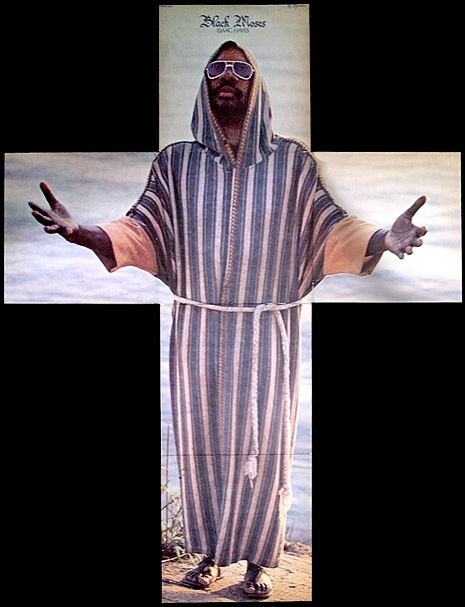
1969’s brilliant Hot Buttered Soul made Isaac Hayes famous as a soul singer, completing his transition to stardom from his past as a behind-the-scenes songwriter and producer. (Did you know that he co-wrote Sam & Dave’s “Soul Man?” That alone would qualify him for eternal exaltation even if he never did anything else.) 1971’s immortal Shaft soundtrack made him indisputably an icon. How do you follow that up? With shitloads of hubris.
It was Dino Woodward who came up with the “Black Moses” tag. “Dino said, ‘Man, look at these people out there,’” explains Isaac. “Do you know what you’re bringing into their lives? Look at these guys from Vietnam, man, how they’re crying when they see you, how you helped them through when they was out there in the jungle and they stuck to your music. You like a Moses, man. You just like Black Moses, you the modern-day Moses!”
“Somebody got wind of that and when I opened in Philadelphia at the Spectrum, [in front of] eighteen thousand people, Georgie Woods, who was a local radio personality and a promoter, introduced me that night. He said, ‘Ladies and gentlemen, I bring to you the Black Moses of the music world—Isaac Hayes,” and the whole place stood, people just screaming and it caught on. A writer for Jet magazine named Chester Higgins did an article on me and he used the term Black Moses, and then [Stax Records’ creative director] Larry Shaw had the savvy to capitalize on it and entitle the album Black Moses.
“I had nothing to do with it. I was kicking and screaming all the way. But when I saw the relevance and effect that it had on people, it wasn’t a negative thing. It was a healing thing, it was an inspiring thing. It raised the level of black consciousness in the states. People were proud to be black. Black men could finally stand up and be men because here’s Black Moses, he’s the epitome of black masculinity. Chains that once represented bondage and slavery can now be a sign of power and strength and sexuality and virility.
—From Soulsville, U.S.A.: The Story of Stax Records by Rob Bowman, 1997
Though that’s a LOT for an artist to carry on his shoulders, Hayes did it. And not only was Black Moses successful at cementing Hayes’ status as a symbol, it was an artistic and marketplace success as well. Moses was Hayes’ second double-LP of 1971, his second consecutive release to spend several weeks at #1 on Billboard‘s R&B album chart, AND his second consecutive Grammy winner. Who else has released two double-albums in one year that both went on to become classics? I can’t think of anyone. (Also, Hayes pulled that feat decades before he adopted the tenets of Scientology. Suck on THOSE chocolate salty balls, L. Ron.)
But if you’re going to assume the mantle of Black Moses, not only does your album have to be excellent, the cover needs to be at least memorable if not iconic. But Stax’ covers of that period were not so hot.
Ever since he had come to Stax, Larry Shaw felt that the company had severely lagged behind in its cover art department. The nadir for Shaw was David Porter’s Gritty, Groovy And Gettin’ It LP, released in February 1970, where a naked Porter was pictured with an equally naked female partner from the armpits up.
“To me,” confesses Shaw, “it was just a nasty presentation of an artist humping some chick. The disrespect that the designers of it had for the artist and the music was not necessary. It was their translation of guts. It was not appropriate.
Stax artwork had improved tremendously since Shaw, with help from former Bar-Kay Ron Gordon, took over its direction. With Black Moses he outdid himself, designing what has to be the most elaborate album package for a black artist up to that point. The two records were encased in a regular cover that portrayed Hayes from the neck up, shrouded in a caftan against a backdrop of endless sky. The cover clearly signified the notion of Hayes as Moses in the Middle East. Enveloping the regular cover was a multi-panel graphic that unfolded into a cross shape four feet high and three feet wide. Here was the same image of Hayes as Moses, but now it was a full body shot with the artist at the edge of a large body of water.
—Bowman

A four foot cruciform Isaac Hayes! I wonder, in how many homes did that hang along with an actual crucifix? In how many instead of an actual crucifix? The 2009 CD reissue, charmingly, reproduces the foldout—underwhelmingly but understandably at CD size. That’s certainly better than the first CD version from 1990, which made no attempt whatsoever to address the fact that the album sported one of the single most badass covers of all time.
Enjoy this Isaac Hayes bio/tribute video, produced for the Stax Museum of American Soul Music in Memphis, TN.